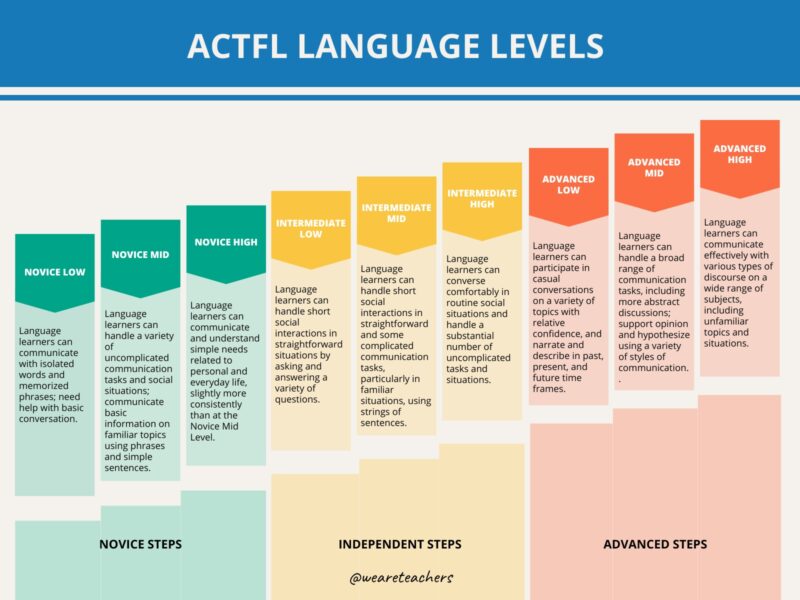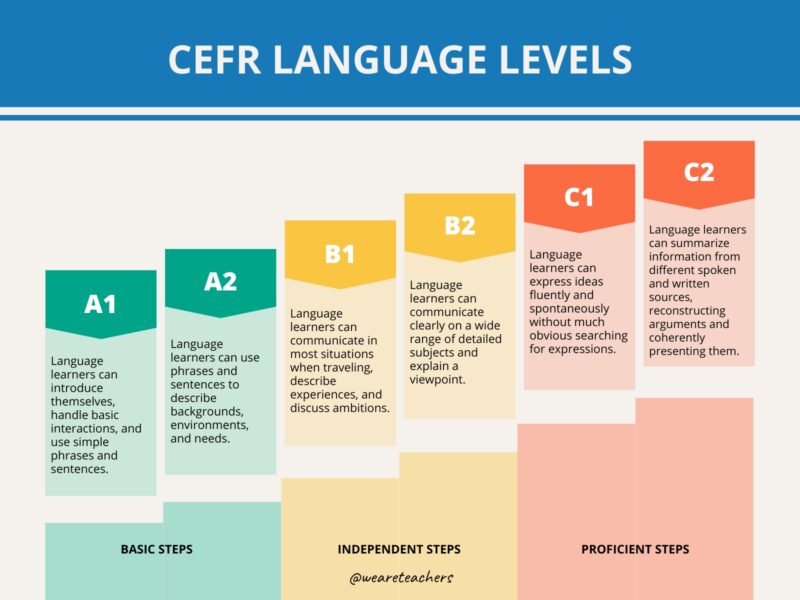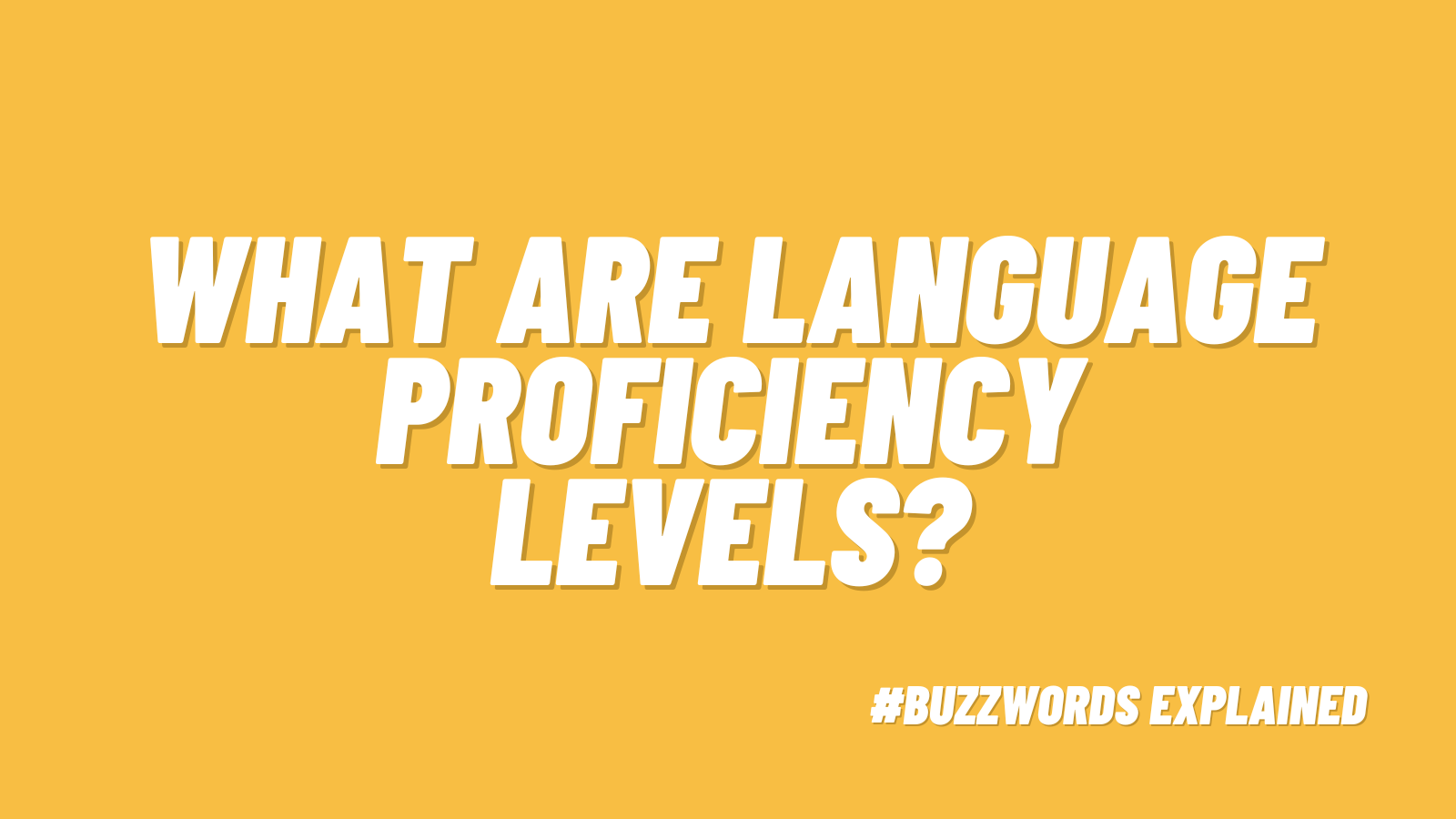Language proficiency is a key element of multi-language learning, and it’s important for both educators and students to understand the different levels of language proficiency. By understanding and integrating these frameworks, such as the American Council on the Teaching of Foreign Languages (ACTFL) and the Common European Framework of Reference for Languages (CEFR), we can help guide our students down the path of learning a language most effectively.
Language Proficiency Levels in Education
When learning a second language, students progress through distinct stages of proficiency. These stages are broadly categorized into beginner, intermediate, advanced, and superior or highly proficient levels. These classifications, while helpful, often overlap, so we should look at them as part of a continuum rather than distinct stages. This approach recognizes the fluid nature of language learning, where students may have skills that span different levels.
Frameworks for Understanding Language Proficiency
In North American and European language proficiency assessment, there are two primary internationally recognized frameworks:
American Council on the Teaching of Foreign Languages (ACTFL) Proficiency Guidelines
ACTFL outlines a range of proficiency levels from Novice to Distinguished. This framework emphasizes what learners can spontaneously do with the language across communicative modes in real-world contexts. This includes speaking, writing, listening, and reading.
Common European Framework of Reference for Languages (CEFR)
This framework categorizes language proficiency into six levels ranging from A1 (beginner) to C2 (master or proficient). It provides a detailed description of what learners can do at each stage in reading, writing, listening, and speaking.
ACTFL Language Levels

The ACTFL (American Council on the Teaching of Foreign Languages) provides a framework to gauge language proficiency. Here’s a breakdown of each of its levels:
Novice (Low, Mid, High)
Novice Low learners can: communicate with isolated words and memorized phrases, but they need help with basic conversation.
Novice Mid learners can: handle a variety of uncomplicated communicative tasks and social situations; communicate basic information on familiar topics using phrases and simple sentences.
Novice High learners can: communicate and understand simple needs related to personal and everyday life, slightly more consistently than at the Mid Novice level.
Intermediate (Low, Mid, High)
Intermediate Low learners can: handle short social interactions in straightforward situations by asking and answering a variety of questions.
Intermediate Mid learners can: handle short social interactions in straightforward and some complicated communication tasks, particularly in familiar situations, using strings of sentences.
Intermediate High learners can: converse comfortably in routine social situations and handle a substantial number of uncomplicated tasks and situations.
Advanced (Low, Mid, High)
Advanced Low learners can: participate in casual conversations on a variety of topics with relative confidence, and narrate and describe in past, present, and future time frames.
Advanced Mid learners can: handle a broad range of communication tasks, including more abstract discussions; support opinion and hypothesize using a variety of styles of communication.
Advanced High learners can: communicate effectively with various types of discourse on a wide range of subjects, including unfamiliar topics and situations.
Superior
Superior learners can: support opinions, hypothesize, discuss topics abstractly, and handle a linguistically unfamiliar situation without strain. Have a broad and deep command of the language, using precise vocabulary and appropriate stylistic nuances.
Distinguished
Distinguished learners can: tailor language to a variety of audiences; alter tone and structure accordingly; and understand cultural references and nuances at a near-native level.
CEFR Language Levels

The Common European Framework of Reference for Languages (CEFR) divides language proficiency into six distinct levels from A1 to C2. This framework was initiated by the Council of Europe in 2001. It standardizes language proficiency assessment not only in Europe but globally, which guides curriculum development and language instruction in educational settings.
CEFR A1 (Basic)
A1 learners can understand and use familiar everyday expressions and perform simple tasks. They mainly use the language for basic, practical communication.
AI learners can: introduce themselves, handle basic interactions, and use simple phrases and sentences.
AI learners struggle with: fluid conversation and complex language structures.
AI learner development: focus on building a foundational vocabulary and basic grammatical structures.
CEFR A2 (Basic)
A2 users can communicate in routine tasks requiring direct exchange of information on familiar matters.
A2 learners can: use phrases and sentences to describe backgrounds, environments, and needs.
A2 learners struggle with: maintaining conversation in less familiar situations.
A2 learner development: expand simple communication to more detailed descriptions and expressions of routine matters.
CEFR B1 (Independent)
B1 learners can usually independently understand and produce language related to familiar topics and personal interests.
B1 learners can: communicate in most situations when traveling, describe experiences, and discuss ambitions.
B1 learners struggle with: longer, coherent narratives or handling complex interactions.
B1 learner development: enhance narrative skills and begin to handle more abstract content in conversations.
CEFR B2 (Independent)
B2 students can interact with a degree of fluency and spontaneity. This makes regular interaction with native speakers quite possible without strain.
B2 learners can: communicate clearly about a wide range of detailed subjects and explain a viewpoint.
B2 learners struggle with: very complex language or unfamiliar cultural references.
B2 learner development: focus on fluency and accuracy, expanding vocabulary to include more abstract and specialized topics.
CEFR C1 (Proficient)
C1 users can understand a wide range of demanding, longer texts and recognize implicit meaning in them.
C1 learners can: express ideas fluently and spontaneously without much obvious searching for expressions.
C1 learners struggle with: minor lapses in complex structures or idiomatic expressions.
C1 learner development: refine language with more complexity for use at school or work.
CEFR C2 (Proficient)
The pinnacle of language proficiency, C2 means students can easily understand just about everything they hear or read.
C2 learners can: summarize information from different spoken and written sources, reconstructing arguments and coherently presenting them.
C2 learners struggle with: subtle issues with extremely complex or highly colloquial language may still pose challenges.
C2 learner development: focus on mastering nuanced language and developing an in-depth understanding of stylistic nuances.
ACTFL vs. CEFR Frameworks
Both the CEFR and ACTFL frameworks help educators determine students’ language proficiency. The CEFR describes specific skills at each level, while ACTFL focuses on practical language use in daily life.
ACTFL is widely used in the United States and places a strong emphasis on communicative competence, making it particularly useful for developing conversational fluency and practical language skills in students. The focus on communicative skills helps provide a straightforward way to address the strengths and weaknesses of each student.
CEFR is often favored for its detailed descriptors that help with curriculum development and standardized testing across Europe and other regions. The specific requirements of each level offer a great reference point for how students should progress incrementally over time.
In 2010, ACTFL started an effort to align the ACTFL and CEFR frameworks with the goal of standardizing language proficiency assessments worldwide.
Assessing Language Proficiency Levels
To assess language proficiency, taking a structured language proficiency test is recommended. These tests evaluate a student’s ability to speak, read, write, and listen in the target language. ACTFL has specific assessments for these skills, while CEFR provides guidelines to map general test scores to its proficiency scale.
According to ACTFL, an optimal proficiency test prioritizes practical language use over theoretical knowledge. This means that the focus is more on how language is applied in the real world rather than on rote learning of grammar rules. A comprehensive proficiency test should cover:
- Communication modes: interpersonal, interpretive, and presentational
- Functional abilities: the various tasks a language learner can perform
- Contextual use: the settings or content areas where the language can be effectively used
- Text types: the range of text types a user can handle, from single words to complex paragraphs
- Language mastery: the learner’s overall command of the language, including communication strategies, cultural and communicative competence, and vocabulary
Research conducted with ACTFL testing methods show that college students typically advance about one-third of an ACTFL sublevel per semester. Students at lower levels improve the quickest.
This research shows that language tests need to accurately measure how well someone can communicate. The tests should be relevant to the learner’s situation and needs. This helps create a more accurate picture of what the learner can really do with the language and helps plan the next steps in their learning.
How To Improve Language Proficiency in Schools
Language proficiency is important for doing well in school and work, especially in a global world. Students, especially those from different language backgrounds, need to build strong language skills. This guide provides effective strategies, using frameworks like CEFR and ACTFL, to help students improve their language abilities for both school and social situations.
Strategies for Improving Language Skills
Immersive Learning Environments
Creating immersive environments where students actively use the language in real-life situations significantly improves language proficiency. Programs such as language exchange and immersion camps encourage comprehensive practice of listening, speaking, reading, and writing skills.
Technology Integration
Using digital tools and applications can make learning more interactive and accessible, providing students with opportunities to engage with the language at their own pace and according to their individual learning styles.
Use of Authentic Materials
Using real-world materials helps students understand the practical use of language. Authentic materials like videos, podcasts, and articles expose students to natural language usage, including various dialects and cultural contexts, which is important for developing practical communication skills.
Regular Constructive Feedback
Providing specific, timely feedback helps students understand their progress and areas needing improvement, focusing on grammar, pronunciation, and practical usage.
Extracurricular Language Practice
Engaging students in language-related extracurricular activities allows them to apply language skills in diverse, real-world situations, improving both fluency and communicative competence.
Culturally Responsive Teaching
Integrating students’ cultural backgrounds into teaching practices improves engagement and effectiveness, fostering an inclusive environment that supports language acquisition.
Cross-Curricular Language Application
This strategy helps students integrate language skills while deepening their understanding of other academic content.
For more content like this, be sure to sign up for our newsletters.
Plus, check out our Bilingualism Myth Busters Printable Poster.


